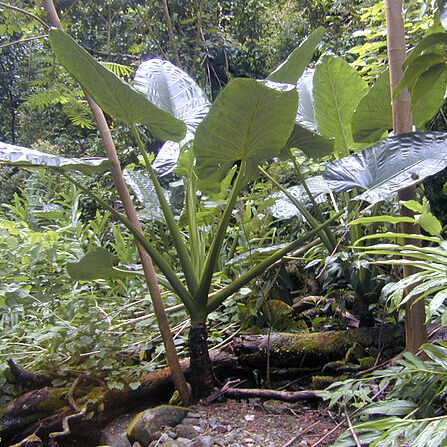Herbs, evergreen, rarely seasonally dormant, latex-bearing, medium sized to rarely arborescent and gigantic. Stem thick, often hypogeal, sometimes stoloniferous and bulbiferous, epigeal stem usually erect and later decumbent, rather less often elongated and creeping. Leaves few to several in terminal crown, less often scattered, sometimes each subtended by a cataphyll; petiole long [sometimes minutely asperous, minutely puberulent, or glandular], sheath relatively long; leaf blade sometimes pubescent abaxially, juvenile blade peltate, at maturity usually sagittate, less often ± hastate or cordate, but remaining peltate in some species, margin entire or sinuate [or slightly to deeply pinnatifid]; posterior divisions ovate or triangular; basal ribs well developed, wax glands present in axils of primary lateral veins and midrib; primary lateral veins pinnate, forming submarginal collective vein, 1 or 2 closely adjacent marginal veins also present, secondary and tertiary lateral veins arising from primaries at a wide angle, then arching strongly toward leaf margin, sometimes forming interprimary veins, higher order venation reticulate. Inflorescences 1 or 2 to many in each floral sympodium; peduncle usually shorter than petioles. Spathe persistent, erect, convolute, gaping only basally, strongly constricted between tube and blade, rarely not; tube with convolute margins, shorter than limb, ovoid or oblong, persistent and then splitting irregularly in fruit; limb oblong, usually boat-shaped, rarely arching, at anthesis at first erect, then reflexing and later usually deciduous. Spadix sessile, sometimes shortly stipitate, rarely obliquely adnate to spathe, shorter than spathe; female zone conic-cylindric, short, separated from male by a much narrower zone of sterile flowers; male zone usually cylindric; appendix conic to cylindric, with irregular, labyrinthine network of fissures. Flowers unisexual, naked. Pistil ovoid or oblong, 1-loculed or partially 3-or 4-loculed at apex; ovules 6-10, orthotropous, hemiorthotropous, hemianatropous, or anatropous; funicle short; placenta basal; stylar region short; stigma depressed capitate, ± distinctly 3-or 4-lobed. Male flowers 3-12(-36)-androus; stamens connate into obpyramidal, subhexagonal, truncate, rarely linear, synandria; thecae oblong to linear-oblong, lateral, dehiscing by apical pore; synandrodes shallow, obpyramidal, compressed, truncate. Fruit a reddish, ellipsoid or obconic-ellipsoid or subglobose odorless berry, 1-5-seeded; stigma remnants persistent. Seed subglobose to ellipsoid, rather large; testa thickish, smooth or scabrous; embryo broadly conic, broadly cylindric, or elongate; endosperm copious.
More
Massive arborescent to decumbent and rhizomatous terrestrial to lithophytic, sometimes diminutive herbs. Leaves (pinnatifid to) sagittate, peltate when juvenile, occasionally so as adults, usually with well-developed posterior lobes; primary venation pinnate; secondary venation ±reticulate, often but not always forming well-defined interprimary collective veins; abaxial leaf surface often with conspicuous glands in axils of primary veins. Inflorescences in pairs (sometimes several in succession without interspersed foliage leaves), orientated tangential to stem (cf. Colocasia), subtended by cataphylls; spathe constricted with limb usually deliquescent or marcescent (rarely persistent); lower spathe persistent and enveloping developing fruits; spadix sessile to stipitate, subequalling to shorter than spathe; female zone without interpistillar staminodes, usually separated from male zone by a ±attenuated sterile zone of synandrodia corresponding to spathe constriction; ovaries unilocular to incompletely 6-locular; ovules few, basal; male zone comprised of usually rhombohexagonal (to elongate) male ‘flowers’ of few (to many) united stamens (synandria); appendix mostly subcylindric, smooth or of sinuous, flattened, close-packed staminodes. Ripe infructescence exposed by dehiscence of persistent spathe base. Fruits red berries containing few seeds, c. 3–5 mm diam.

